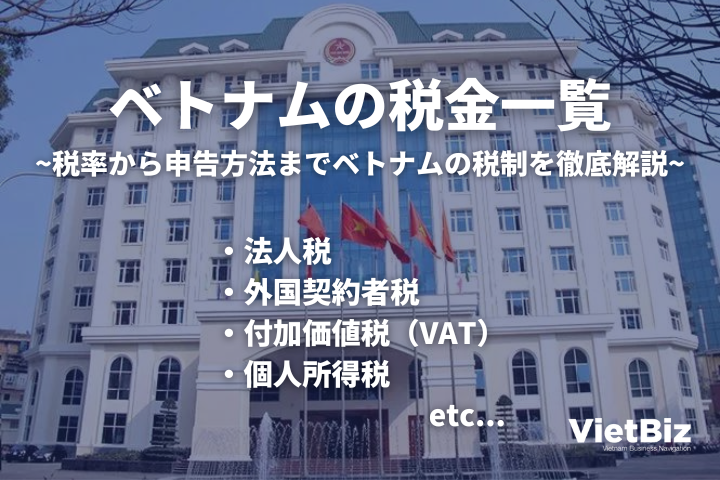Introduction:Types of Taxes in Vietnam
In addition to the familiar Japanese tax systems such as corporate income tax and personal income tax, Vietnam also has its own unique taxes such as foreign contractor tax. This report provides a summary of the various taxes in Vietnam, including an overview, tax rates, and calculation methods. This information is essential for doing business in Vietnam, and we hope that businesspersons who are considering expanding overseas or into Vietnam will find it useful.
Corporation Tax
Corporate income tax is a tax levied on income derived from the business activities of a corporation.
Tax Rate
The standard corporate income tax rate in Vietnam is 20%; it was reduced from 25% to 22% in 2014 and to 20% in 2016. A tax rate of 32-50% applies to income from exploration, prospecting, and development activities of rare and important resources, such as oil and gas projects. There is also a preferential tax regime.
Calculation Method
The tax amount is calculated by multiplying taxable income by the tax rate. Taxable income is calculated by adjusting pre-tax income for non-deductible and taxable items and deducting tax loss carryforwards. The conditions for deductibility in Vietnam are stricter than in Japan, and all of the following conditions must be met: (1) the expenses must be related to the company’s business activities, (2) the company must have appropriate vouchers such as VAT invoices and contracts, and (3) transactions over 20 million VND must be settled by non-cash means such as bank transfer or credit card payment. The loss must be paid in 5 years from the year following the year in which the loss is incurred. Tax losses are allowed to be carried forward for five years from the year following the year in which they arise.
Typical examples of non-deductible items include the following
| Salaries, etc. | Voluntary pension contributions are deductible up to VND3 million per employee per month. Amounts exceeding this are not deductible. |
| Donation | Except for certain donations to education funds, medical insurance funds, etc., the donations are not deductible. |
| Reserves | As a general rule, provisions are not deductible. Certain credits beyond the due date are deductible up to the limit. |
Typical examples of items not deductible for tax purposes are as follows.
| Dividend income | Dividends received from Vietnamese corporations are exempt from taxation if the paying corporation is taxed in Vietnam. Dividends received from a foreign corporation are subject to taxation (in this case, foreign tax credit is available). |
Taxable Subject
Tax is levied on income derived from the business activities of a legal entity. In principle, a legal entity established in Vietnam is considered a resident and is taxed on its worldwide income.
How to Report
Vietnamese corporate income tax must be declared and paid within 90 days of the end of the taxable year. In addition, interim payments (no declaration required) must be made quarterly. If the total of interim payments up to the third quarter is less than 75% of the final tax amount, a delinquency tax is imposed.
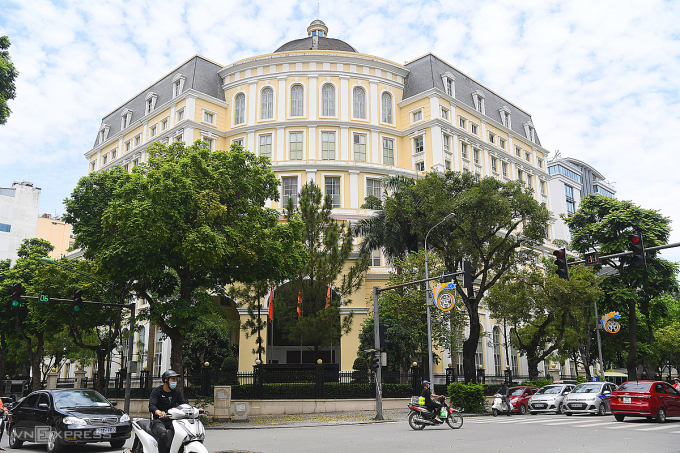
Foreign Subscriber Tax
Vietnam’s foreign contractor tax is a tax imposed on income and value added earned by foreign corporations or individuals in Vietnam. It consists of a corporate income tax (CIT) component and a value-added tax (VAT) component.
Tax Rate
In Vietnam, the tax rate differs between the VAT portion and the CIT portion depending on the nature of the transaction. Details are shown in the list below.
| Contents | VAT(%) | CIT(%) |
| Sale of goods with provision of services | – | 1 |
| Construction (not involving the delivery of materials or machinery) / installation | 5 | 2 |
| Construction (with material or machinery benefits)/installation and transportation services | 3 | 2 |
| General services, machinery and equipment leasing, insurance services | 5 | 5 |
| interest (bank) | – | 5 |
| royalty | – | 10 |
| Restaurant, hotel and casino management services | 5 | 10 |
| Securities transfers, reinsurance commissions | – | 0.1 |
| derivative transaction | – | 2 |
| Other businesses | 2 | 2 |
Calculation Methods
In Vietnam, the direct method is generally adopted, where the tax amount is calculated by multiplying the contract amount by the deemed tax rate (see table above); the CIT portion is the tax base of the contract amount, and the VAT portion is the contract amount plus the CIT tax amount. Other calculation methods, such as the deduction method and the hybrid method, are also used, but they are not generally adopted.
Taxable Subjects
The tax is levied on the consideration for services rendered to Vietnam by a corporation or individual outside of Vietnam. This means that the tax is on the costs of Vietnamese corporations. It does not apply to the revenue of the Vietnamese corporation. The tax is imposed regardless of whether or not the person is a resident of Vietnam or has a PE (Permanent Establishment) in Vietnam in performing services in Vietnam.
How to Report
In the case of the direct method, the Vietnamese corporation is required to withhold the VAT and CIT portion from the foreign corporation and make the declaration and payment within 10 days from the date of payment. In order to declare foreign contractor tax, the tax code registration of the foreign contractor is required.
Value Added Tax (VAT)
Vietnam’s value-added tax (VAT) is a tax imposed on the value added created by businesses through their business activities, and is similar in concept to the consumption tax in Japan. Businesses collect VAT from customers when they sell goods and services (sales VAT) and pay VAT on purchases (purchase VAT).
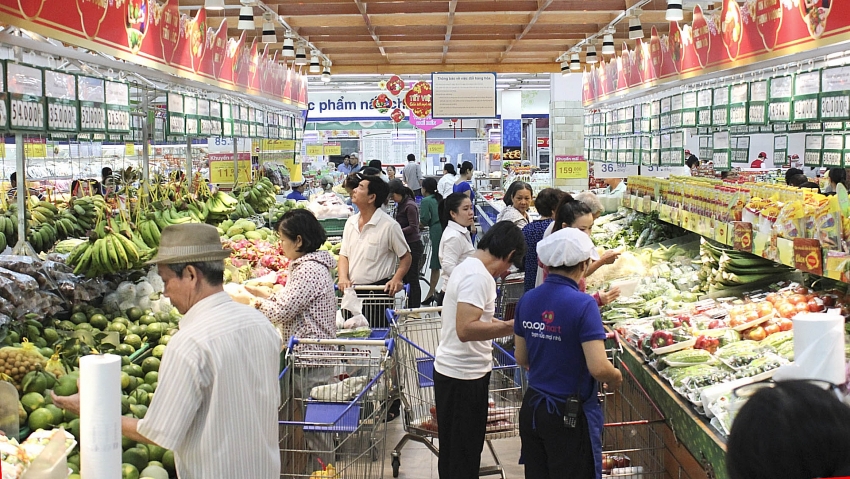
Tax Rate
The standard VAT rate is 10%, but for social policy reasons, 0% or 5% will be applied to some transactions. In addition, from February 1 to December 31, 2022, the standard rate will be reduced from 10% to 8%. This is a time-limited measure to support businesses affected by the new coronavirus and to help the economy recover. Products and services eligible for the tax cut are those to which the standard tax rate of 10% applies, but certain transactions, such as financial, banking, and securities transactions, are exempt.
The 5% rate applies to essential goods and services such as water, fertilizers, educational materials, foodstuffs, pharmaceuticals and medical equipment, agriculture, and scientific and technical services, etc. The 0% rate applies to exported goods and services, and construction and installation services outside Japan and in non-tariff areas, etc. To apply the 0% rate The 0% tax rate must be applied to all goods and services exported from the country, and all conditions must be met, such as having a contract or other stipulated documents.
| Tax Rate | Target Transaction |
| 10% | Sales of goods and services other than 5% or 0%. |
| 5% | Essential goods and services Water, fertilizers, educational materials, food, pharmaceuticals and medical equipment, agriculture, scientific and technical services, etc. |
| 0% | Transactions related to exports Export goods and services, construction and installation services in foreign countries and non-tariff areas, international transportation, etc. |
Calculation Methods
There are two methods of calculation: the deduction method and the direct method. The deduction method calculates the tax amount as the difference between VAT on sales and VAT on purchases. The direct method, on the other hand, is calculated by multiplying the taxable value by the tax rate (see table above) set by law.
Taxable Subjects
The tax is levied on the sale, provision, and importation of goods and services for manufacture, business, and consumption in Vietnam. From a social policy perspective, certain goods and services such as unprocessed agricultural, forestry, and fishery products, water supply and sewage, products of the domestic livestock and nursery industries, land use rights transfers, and medical services are excluded from the tax.
How to Report
In principle, monthly declaration and payment is required, and the declaration and payment must be made by the 20th of the following month. However, if the annual turnover of the previous year is 50 billion VND or less, it is possible to file quarterly.
Personal Income Tax
In Vietnam, taxpayers are divided into resident and non-resident taxpayers, and different coverage and tax rates are stipulated for each.
Tax Rate
| Type of income | residents | non-residents |
| earned income | Cumulative tax rate 5% – 35 | 20% |
| business income | 0.5%~5% | 1%~5% |
| investment income | 5% of profit | 5% of profit |
| Investment income (of which: capital gains/losses) | 20% of profit | 0.1% of the transaction amount |
| Investment income (of which: gains/losses on transfer of securities) | 0.1% of the transaction amount | 0.1% of the transaction amount |
| capital gains from real estate transfer | 2% of the transaction amount | 2% of transaction value |
| royalty income | 5% on amounts exceeding VND10 million | 5% on amounts exceeding VND10 million |
| Income from Inheritance | 10% on amounts exceeding VND10 million | 10% on amounts exceeding VND10 million |
| Income from gifts | 10% on amounts exceeding VND10 million | 10% on amounts exceeding VND10 million |
Calculation Methods
The calculation of personal income tax in Vietnam is similar to that in Japan.
Income tax amount = (taxable gross income – income tax credit) * applicable income tax rate
Taxable Subjects
Individuals who fall into the following categories are subject to personal income tax
| Terms | ||
| residents | Those staying for more than half of the year | ・Those who have stayed in Vietnam for more than 183 days in a calendar year ・Those who have stayed in Vietnam for more than 183 days in a consecutive 12-month period starting from the date of entry into Vietnam |
| Persons who have a permanent residence in Vietnam | ・Those who have a permanent residence (in the case of foreigners, the residence registered on their resident card) ・Those who have a rental house, etc. with a contract period of 183 days or longer | |
| non-residents | Persons who do not fall under the above categories of residents | |
| Others | ・Vietnamese nationals who work, study, or research outside of Vietnam and have taxable income ・Foreign workers earning income in Vietnam ・Foreigners who are not resident in Vietnam but have domestic source income in Vietnam etc |
How to Report
In Vietnam, as in Japan, corporations are obligated to withhold tax and pay monthly tax in the form of year-end adjustments, and to file their own tax returns at the end of the year. Taxes are due on the 20th of each month for monthly tax returns, and within 90 days of the end of the calendar year for annual tax returns. Tax returns may also be filed quarterly. In this case, the return must be filed within 30 days of the end of the quarter.
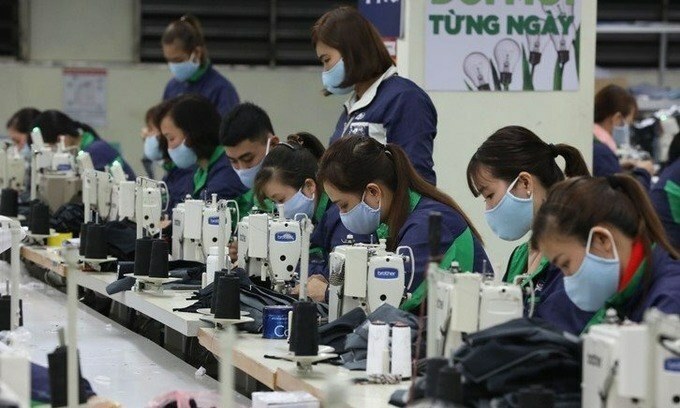
Other Taxes
Below is a description of other taxes in Vietnam applicable to specific industries, etc.
Natural Resources Tax
Vietnam’s natural resources tax is a tax imposed on individuals or legal entities that develop and use certain natural resources as specified in the law. The tax is levied mainly on the development of the following types of resources
・Metals and Steel
・nonferrous metals
・natural gas
・Natural forests (excluding those artificially grown and protected)
・fishery resources
・Natural water (excluding natural water used for agriculture, industry and other industrial purposes)
・natural swallow’s nest
・Other Resources
Calculation Methods
Taxes are calculated as follows
Tax = Quantity * Unit price * Tax rate
The tax rate applied varies depending on the resource. Resource tax rates range between 1% and 40%. For example, 17% for gold, 15% for copper, 10% for natural water, etc. For more detailed tax rates for each item, please contact the VietBiz editorial office.
How to Report
Each month, a declaration must be prepared and submitted to the authorities based on the quantities pioneered in that month.
Address for Filling a Return
If the location where the resource development is taking place and the location of the head office are the same, the tax return should be submitted to the tax office of the region where the head office is located. If the location of the resource development and the location of the head office are different, the tax return should be submitted to the tax office of the region where the resource development is conducted.
Environmental Conservation Tax
Vietnam’s environmental protection tax is a separate tax on goods that have a negative impact on the environment. Examples include plastic bags and gasoline.
Calculation Methods
Unlike other taxes, the environmental protection tax is not calculated in terms of a tax rate, but rather a fixed amount per unit of quantity. For example, gasoline is charged at VND4,000 (approximately 20 yen) per liter, and plastic bags are charged at VND50,000 (approximately 250 yen) per kilogram.
How to Report
The timing of payment of the environmental protection tax varies from product to product.
| Production and replacement goods for sale and purchase | Taxes are imposed when ownership is transferred. |
| Production products for internal use | Taxes are imposed as soon as the use is initiated. |
| Imports (except gasoline for sale and purchase) | Taxes are imposed at the same time as tariffs. |
| Gasoline for sale and purchase | Taxes are imposed at the point of sale and purchase. |
Address for Filling a Return
Taxpayers are obligated to pay taxes directly to the tax office. If the location of the head office is different from the place of production, the tax return must be submitted to the tax office of the place of production.
Nonagricultural Use Tax
Vietnam’s non-agricultural land use tax is imposed on individuals or corporations that have the right to use land that falls under the following categories, multiplied by a certain tax rate.
・Residential land in rural and urban areas
・Non-agricultural land for industrial and commercial use: land for development of industrial parks, land for construction of production sites, land for mineral excavation, land for production of construction materials, land for production of ceramics
・Other non-agricultural land used for business purposes
For example, an apartment owner would be required to pay a non-agricultural land use tax in addition to the land use fee.
Calculation Methods
Taxes = per square meter * tax rate
The tax rates are cumulative and are imposed at the following rates
| Level | Area (square meters) | Tax rate(%) |
| 1 | Area within the limits specified by law | 3% |
| 2 | Area in excess of the area specified by law by a factor of not more than 3 | 7% |
| 3 | Area in excess of three times the area specified by law | 15% |
How to Report
Non-farm use tax must be paid twice each year, on May 31 and October 31. In addition, if there are any changes in the information on the return, the return must be filed within 30 days of the date of the change.
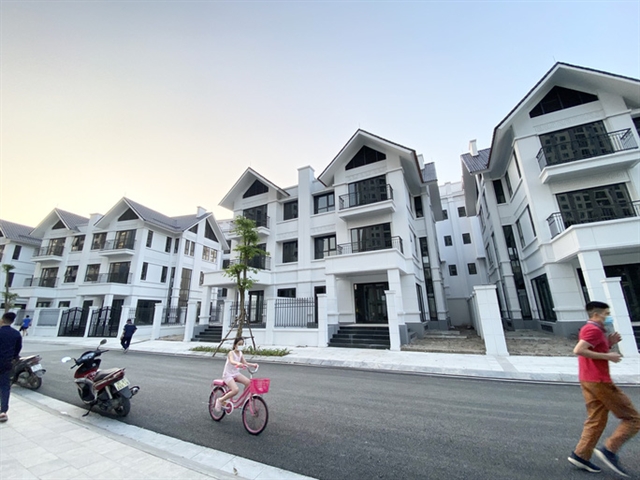
Transfer Princing Taxation System
Vietnam’s transfer pricing taxation system is designed to prevent tax evasion by transferring one’s own profits to affiliated companies by setting transaction prices of related parties (affiliated companies and individuals) at prices that differ from those of transactions with third-party companies (arm’s length prices).
関連者の定義
If any of the following criteria are met, the company is considered a “related party” and is subject to transfer pricing taxation
| standerd | definition |
| ownership interest | ・25% or more directly or indirectly – Largest shareholder, holding 10% or more directly or indirectly. |
| Number of directors | ・Appointment of more than half of the total number of officers, etc., or such appointed officers, etc., having decision-making authority over the management or financial activities of the other party, etc. |
| degree of dependence on capital | ・Borrowings from related parties or guaranteed and borrowed by related parties amounting to at least 25% of capital and at least 50% of total medium- to long-term borrowings |
| consanguinity | ・Family members involved in the management activities or financial and human resource decisions of the enterprise |
| Other special relationships | ・Same head office address |
In addition, in the case of Japan, only foreign related-party transactions are subject to transfer pricing taxation, while in the case of Vietnam, domestic related-party transactions are also subject. It should be noted that the scope of the taxation system is broader than in Japan.
Transfer Pricing Analysis Methodology
The amendment allows five methods of analysis for determining arm’s length prices, as follows
・CUP: Comparable net profit method
・RPM: Resale price method
・CPLM: Cost plus method
・CPM: Comparable net profit method
・PSM: Profit split method
Among the above five methods, an entity should select the most appropriate transfer pricing analysis method after considering multiple factors such as the nature and circumstances of the related-party transaction and available data.
CUP: Comparable net profit method
The Vietnamese government has established that the most appropriate arm’s length price should be a figure that falls within the 35th to 75th percentile of prices obtained from at least five comparable companies. If an arm’s length price is determined to be inappropriate by the tax authorities, additional taxes will be levied retroactively. Therefore, each company will need to review its own pricing to ensure that it is appropriate.
Transfer Pricing Documentation and Principles
Taxpayers are required to prepare and furnish the following three types of transfer pricing documentation
・Local files: information on business, price analysis methods, etc.
・Master File: Information on management activities of overseas operations and transfer pricing analysis methods for the entire group.
・CbCR: Country by Country Report:Provide business results and other information for each region in which the taxpayer is active.
However, if the following conditions are met, the above documentation obligation is waived
| Only domestic intercompany transactions, with the same corporate tax rate applied to all intercompany transactions, and without any preferential corporate tax treatment. |
| Annual turnover is less than VND50 billion (approximately ¥250 million) and the total amount of transactions between related parties is less than VND30 billion (approximately ¥150 million). |
| APA: Advance Pricing Arrangement is in place and the annual report for the APA has been submitted. |
| Annual turnover is less than VND200 billion (approximately 1 billion yen) and the following conditions are met The Vietnamese subsidiary has only simple functions and does not develop or use intangible assets. The ratio of operating income before interest and taxes to net sales exceeds the ratios specified for certain industries (5% for sales, 10% for manufacturing, and 15% for processing). |
Points to Keep in Mind for Japanese Companies
Since the Vietnamese transfer pricing taxation system differs from the Japanese transfer pricing taxation system in many respects, it is necessary to have a thorough understanding of the system and to calculate appropriate arm’s length prices based on the standards.
In addition, advance preparation is the most important factor in responding to a tax audit. Companies need to prepare documents in advance to explain why they conducted transactions with affiliated companies at these prices. If a company is unable to explain this reason or lacks the necessary documentation, it will be deemed to have engaged in transfer pricing transactions and may be subject to additional taxation.
Conclusion
In this issue, we have explained the main taxes in Vietnam, focusing on basic concepts and how to calculate the taxable amount. Even Japanese-affiliated companies are required to pay taxes in accordance with Vietnamese tax laws as long as they have a local subsidiary in Vietnam. Foreign companies, including Japanese companies, are frequently subject to tax audits by the Vietnamese tax office, and if a tax audit reveals that a company has violated Vietnamese tax law, the company will be subject to a hefty penalty, so caution is required.
For more specific tax declaration procedures and tax consultation, it is recommended to consult with professionals familiar with Vietnamese tax laws and receive consulting and other support.
【関連記事】ベトナムの税制と関連分野については、こちらの記事も合わせてご覧ください。
ベトナム市場調査レポート一覧はこちらからもご覧頂けます。

